Chapter: Operations Research: An Introduction : Modeling with Linear Programming
Selected LP Applications: Investment
SELECTED LP APPLICATIONS
This section presents realistic LP models in which the definition of the variables and the construction of the objective function and constraints are not as straight-forward as in the case of the two-variable model. The areas covered by these appli-cations include the following:
1. Urban planning.
2. Currency arbitrage.
3. Investment.
4. Production planning and inventory control.
5. Blending and oil refining.
6. Manpower planning.
Each model is fully developed and its optimum solution is analyzed and interpreted.
Investment
Today's
investors are presented with multitudes of investment opportunities. Examples
of investment problems are capital budgeting for projects, bond investment
strate-gy, stock portfolio selection, and establishment of bank loan policy. In
many of these situations, linear programming can be used to select the optimal
mix of opportunities that will maximize return while meeting the investment
conditions set by the investor.
Example 2.3-3
(Loan Policy Model)
TIlfiftem
Bank is in the process of devising a loan policy that involves a maximum of $12
million. The following table provides the pertinent data about available types
of loans.
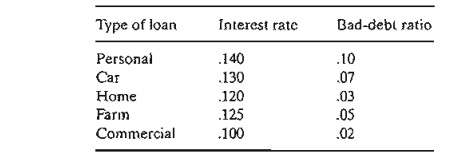
Bad debts
are unrecoverable and produce no interest revenue.
Competition
with other financial institutions requires that the bank allocate at least 40%
of the funds to farm and commercial loans. To assist the housing industry in
the region, home loans must equal at least 50% of the personal, car, and home
loans. TIle bank also has a stated policy of not allowing the overall ratio of
bad debts on all loans to exceed 4%.
Mathematical Model: The
situation seeks to determine the amount of loan in each category, thus leading
to the following definitions of the variables:
xi =
personal loans (in millions of dollars)
x2
= car loans
x3
= home
loans
x4
= farm
loans
x5 =
commercial
loans
The
objective of the Thriftem Bank is to maximize its net return, the difference
between interest revenue and lost bad debts. The interest revenue is accrued
only on loans in good standing. Thus, because 10% of personal loans are lost to
bad debt, the bank will receive interest on only 90% of the loan-that is, it
will receive 14% interest on .9x( of the original loan XI' The same
reasoning applies to the remaining four types of loans. Thus,
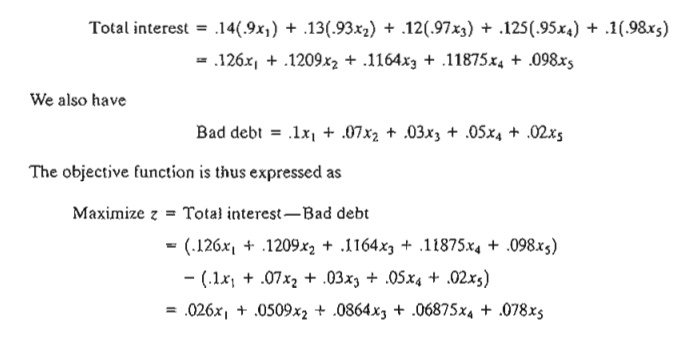
The
problem has five constraints:
1. Total funds should not exceed $12 (million):

2. Farm and commercial loans equal at least 40%
ofall loans:

3. Home loans should equal at least 50% of personal, car, and home loans:

4. Bad debts should not exceed 4% ofall loans:

5. Nonnegalivily:

A subtle
assumption in the preceding formulation is that all loans are issued at
approxi-mately the same time. 'This assumption allows us 10 ignore differences
in the time value of the funds allocated to the different loans.
Solution:
The
optimal solution is
z = .99648, xl = 0, x2 = 0, x3 = 7.2, x4 = 0, x5 = 4.8
Remarks.
1. You
may be wondering why we did not define the right-hand side of the second
constraint as.4 x 12 instead of .4(x1 + x2 + x3 + x4 + x5). After
all, it seems logical that the bank would want to loan out all $12 (million).
The answer is that the second usage does not "rob" the model of this
possibility. If the
optimum solution needs all $12 (million), the given con-straint will allow it.
But there are two important reasons why you should not use .4 X 12: (1) If other constraints in the model
are such that all $12 (million) cannot
be used
(for example, the bank may set caps on the different loans), then the choice .4
X 12 could lead to an infeasible
or incorrect solution. (2) If you want
to experiment with the effect of changing available funds (say from $12 to $13
million) on the optimum solution, there is a real chance that you may forget to
change.4 x 12 to.4 x 13, in which case the solution you get will not be
correct. A similar reasoning applies to the left-hand side of the fourth
constraint.
2. The
optimal solution calls for allocating all $12 million: $7.2 million to home
loans and $4.8 million to commercial loans. The remaining categories receive
none. The return on the investment is computed as

This
shows that the combined annual rate of return is 8.034 %, which is less than
the best net interest rate (=
.0864 for home loans), and one wonders why the optimum does not . take advantage of this opportunity. The
answer is that the restriction stipulating that farm and commercial loans
account for at least 40% of all loans (constraint 2) forces the solution to
allocate $4.8 million to commercial loans at the lower /let rate of
.078, hence lowering the overall interest rate to [.0864 x 7.2 + .078 x 4.8 ]/ 12= .08034.
In fact, if we remove constraint 2, the optimum will allocate all the funds to
home loans at the higher 8.64% rate.
PROBLEM
SET 2.3C
1. Fox
Enterprises is considering six projects for possible construction over the next
four years. The expected (present value) returns and cash outlays for the
projects are given below. Fox can undertake any of the projects partially or
completely. A partial undertak-ing of a project will prorate both the return
and cash outlays proportionately.
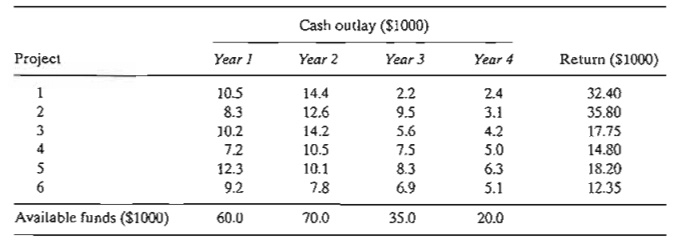
a.Formulate the problem as a linear program, and determine the optimal project mix that maximizes the total return. Ignore the time value of money.
b.Suppose that if a portion of project 2 is undertaken then at least an equal portion of project 6 must undertaken. Modify the formulation of the model and find the new optimal solution.
c.In the original model, suppose that any funds left at the end of a year are used in the next year. Find the new optimal solution, and determine how much each year "bor-rows" from the preceding year. For simplicity, ignore the time value of money.
d.Suppose in the original model that the yearly funds available for any year can be ex-ceeded, if necessary, by borrowing from other financial activities within the company. Ignoring the time value of money, reformulate the LP model, and find the optimum solution. Would the new solution require borrowing in any year? If so, what is the rate of return on borrowed money?
2.
Investor Doe has $10,000 to invest in four projects. The following table gives
the cash flow for the four investments.
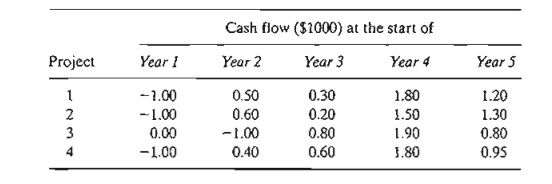
The
information in the table can be interpreted as follows: For project 1, $1.00
invested at the start of year 1 will yield $.50 at the start of year 2, $.30 at
the start of year 3, $1.80 at the start of year 4, and $1.20 at the start of
year 5. The remaining entries can be interpreted similarly. The entry 0.00
indicates that no transaction is taking place. Doe has the additional option of
investing in a bank account that earns 6.5% annually. All funds ac-cumulated at
the end of one year can be reinvested in the following year. Formulate the
problem as a linear program to determine the optimal allocation of funds to
investment opportunities.
3. Hi
Rise Construction can bid on two I-year projects. The following table provides
the quarterly cash flow (in milIions of dollars) for the two projects.

HiRise
has cash funds of $1 million at the beginning of each quarter and may borrow at
most $1 million at a 10% nominal annual interest rate. Any borrowed money must
be re-turned at the end of the quarter. Surplus cash can earn quarterly
interest at an 8% nomi-nal annual rate. Net accumulation at the end of one
quarter is invested in the next quarter.
a. Assume that HiRise is allowed partial or full participation in the two projects. De-termine the level of participation that will maximize the net cash accumulated on 12/31/2008.
b. Is it possible in any quarter to borrow money and simultaneously end up with sur-plus funds? Explain.
4. In
anticipation of the immense college expenses, a couple have started an annual
investment program on their child's eighth birthday that will last until the
eighteenth birthday. The couple estimate that they will be able to invest the
following amounts at the beginning of each year:

To avoid
unpleasant surprises, they want to invest the money safely in the following options:
Insured savings with 7.5% annual yield, six-year government bonds that yield
7.9% and have a current market price equal to 98% of face value, and nine-year
municipal bonds yielding 8.5% and having a current market price of 1.02 of face
value. How should the couple invest the money?
5. A
business executive has the option to invest money in two plans: Plan A
guarantees that each dollar invested will earn $.70 a year later, and plan B
guarantees that each dollar invested will earn $2 after 2 years. In plan A,
investments can be made annually, and in plan B, investments are allowed for
periods that are multiples of two years only. How should the executive invest
$100,000 to maximize the earnings at the end of 3 years?
6. A
gambler plays a game that requires dividing bet money among four choices. The
game has three outcomes. The following table gives the corresponding gain or
loss per dollar for the different options of the game.
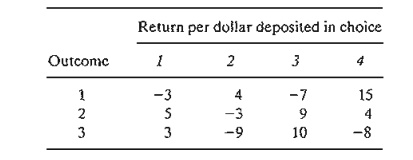
The
gambler has a total of $500, which may be played only once. The exact outcome
of the game is not known a priori. Because of this uncertainty, the gambler's
strategy is to maximize the minimum
return produced by the three outcomes. How should the gambler allocate the $500
among the four choices? (Hint:The gambler's
net return may be positive, zero, or negative.)
7. (Lewis,
1996) Monthly bills in a household are received monthly (e.g., utilities and
home mortgage), quarterly (e.g., estimated tax payment), semiannually (e.g.,
insurance) ,or annually (e.g., subscription renewals and dues). The following
table provides the monthly bills for next year.

To
account for these expenses, the family sets aside $1000 per month, which is the
average of the total divided by 12 months. If the
money is deposited in a regular savings account, it can earn 4% annual
interest, provided it stays in the account at least one month. The bank also
offers 3-month and 6-month certificates of deposit that can earn 5.5% and 7%
annual interest, respectively. Develop a 12-month investment schedule that will
maximize the family's total return for the year. State any assumptions or
requirements needed to reach a feasible solution.
Related Topics